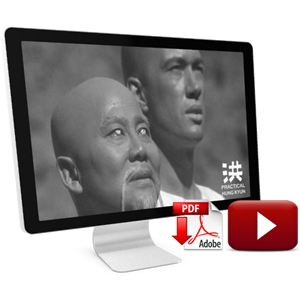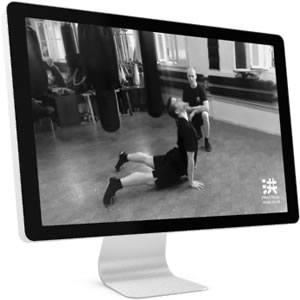
One of my fondest memories of my Sigung (師公), the Great-Grandmaster Lam Cho, was when he would put on his three-piece suit, pick up a newspaper, and take a brisk walk for lunch at his favorite restaurant, where he had a table reserved daily, between the hours of 1:00-2:30pm. On the occasion of one visit, in the early 1990’s, I had brought a variety of Chinese martial art books from my home in San Francisco, USA.
Arriving at Lam Kwoon (林館), Great-Grandmaster Lam Cho and my Sifu (師父), Grandmaster Lam Chunsing were ready to have lunch, and so we walked together, to Sigung’s restaurant, the old Joy Fook Lau Seafood Restaurant (彩福海鮮酒樓), on the fourth floor of the Pioneer Centre, 750 Nathan Road. On this particular day, I had brought the books with me, with the intention of discussing them with my Sifu.
Once shown to our table by the elegant and charming wait-staff, Si Gung proceeded to enjoy his newspaper and the horse racing stats. Sifu then noticed my books and asked what I was reading.
I then brought out my selection of books on various northern and southern styles, both in Chinese and in English, including Pek Gwa (劈掛門), Eagle Claw (應爪派), Northern Seven-Star Praying Mantis (七星螳螂拳), Taijiquan (太極拳), White Crane (白鶴), Hap Ga Kyun (俠家拳), Choi Lei Fat (菜李佛), Wing Cheun Kyun (永春拳), Mok Ga Kyun (莫家拳), several books on Hung Kyun (洪拳), and finally a publication from mainland China, titled “Lau Kyun (劉拳).”
Ordinarily, when Sigung was reading, I would patiently wait for him to finish, but in this case, he became quite interested, put his newspaper down, and then said that he would like to have a look.
Sifu and I both watched, as Sigung sorted through the books, he would briefly comment now and again, taking note of all the various styles. Then, when he saw the “Lau Kyun” book, he began to study it intently. As he read, for some period of time, I did not interrupt him, visiting instead with Sifu.
 Presently Sigung stated, “Well, they certainly do have a long horse stance section, in this set.” In similar manner to our own War Palm Set (戰掌拳), the form in the book did indeed display a lengthy horse stance section (騎馬式部) prior to demonstrating its various footwork-based techniques.
Presently Sigung stated, “Well, they certainly do have a long horse stance section, in this set.” In similar manner to our own War Palm Set (戰掌拳), the form in the book did indeed display a lengthy horse stance section (騎馬式部) prior to demonstrating its various footwork-based techniques.
I then asked Sigung if he knew of the authors and the lineage that they referenced, “Hung, Lau, Choi, Lei, Mok (洪劉菜李莫)” and “Three-Eyed” Lau (劉三眼), and if this was where the set Lau Ga Kyun (劉家拳) comes from, that we, as Lam Family Hung Kyun (林家洪拳) students all learn and practice.
Sigung replied, “It’s difficult to say for sure, there are many branches, and many stories, especially in China today. I don’t know who these people are. Other than being an obvious southern boxing compilation, with a decidedly modern flair (武術拳南), their Kung Fu is not recognizable or familiar.
“The set of Lau Ga Kyun, that I teach, is something that I originally learned from a classmate of mine under Lam Saiwing. This classmate had a background in Mok Ga Kyun, his name was Mr. Lau (劉).”
“Lau family set” (Lau Ga Kyun) performed by young disciples of Grandmaster Lam Chun Sing, China 2009
I then asked Sigung, “Does this mean that the Lau Ga Kyun which we practice today, is not the same Lau Ga Kyun, as from the Guangdong Southern Boxing Five Famous Families (廣東南拳五大名家)?”
Sigung confirmed, “There may in fact be a branch somewhere, of such a Lau Ga Kyun system. However, ours is definitely not the same, because I adapted this set personally, from a single set of Mok Ga Kyun that I had initially picked up, from a student of my Uncle, named ‘Mr. Lau.’
Sigung continued, “In my Uncle’s school, Mr. Lau and I were friends, and would often practice together. I was impressed with how this technique would use the cutting palms to draw the opponent in, suddenly reversing into a heavy palm-strike, with force sufficient to make an opponent lay down from a single blow. For this reason, as well as the different strikes, unique Mok Ga Kyun kicks, and the hands to set them up, I adapted this set into my personal practice, and made certain, specific changes.”
“Understand, the Mok Ga system of Mr. Lau, was specialized on the Phoenix-Eye strike (鳳眼搥), and the frame was to be short bridge, narrow stance (窄馬短橋), quite similar to Southern Mantis (南螳螂拳). Therefore, while keeping techniques that I liked, and the general layout of the set, I removed all but two of the Phoenix Eye strikes, widened the stance and adjusted the bridge, so as to be suitable for Hung Kyun practitioners.
Lau Ga Kyun, performed by Grand Master Leung Gaam Kwong
Sigung continued, “I had also picked up a Southern Mantis long pole set (長棍), from a student of Lau Seui (劉水), as he likewise was studying with my Uncle. I learned the techniques, and adapted them to Hung Kyun measures (尺寸) and principles (兵器的原理), in like fashion to the way I had done with the Lau Ga Kyun.”
“I further added the Lau Ga Kyun inception movement (開式) to the Lau Ga Gwan set, thus to have a matching pair, of ‘Lau Ga Kyun, and Lau Ga Gwan.’
“When I began teaching, the students also liked this, therefore I taught them as well. Lau Ga Kyun instills good basics, but is quicker to learn than the “Gung” Pattern Tiger Subduing Set (工字伏虎拳), and therefore suitable for beginners. For more advanced students, the different techniques the set has to offer can provide additional perspective.
“The students learned these sets from me, as well as a number of others. My Uncle Lam Saiwing’s Kung Fu, was likewise quite distinctive, and from such differences, as a matter of course, one also may understand, who learned exactly what, and from who.”

By this time, the meal was finished. When we returned to Lam Kwoon, Sigung requested that I leave the books with him, to look through at his leisure. I could not possibly have been happier to do so! For weeks, these were an ongoing topic of discussion, as Sigung explained in detail the advantages and disadvantages of the various styles, what he liked himself, what he did not care for, and why.
In summary, in light of our Great-Grandmaster Lam Cho providing such insight into his process, we may now more fully appreciate, in Lam Family Hung Kyun, the Lau Ga Kyun, and Lau Ga Gwan.
About the Author: Sifu Michael Goodwin is the founder of the San Francisco Hung Gar Kung Fu Association, in San Francisco, California, with branches in Toronto, Canada, and in Santiago de Chile. He has been a practitioner of Lam Family Hung Kyun since 1976.
If you like the article and if you want to support our work, please add your comment, click “tweet” or “like”. Your support will help us and encourage us to publish and share more articles and videos in the future!
Thank you for every visit, “tweet”, “like” or comment!
Upcoming Events!
[events_list]
-

Chinese Martial Arts: The Secrets of the Old Grandmasters
$9,95 Add to cart -
Sale!

PHK Intro Kit: Beginner’s Guide to Chinese Martial Arts
Original price was: $149,00.$79,00Current price is: $79,00. Add to cart -

Chan Hon Chung Sifu – “Moon Shadow Hand & Kick Poster
$9,95 Add to cart -

Chan Hon Chung’s Tiger and Crane Double Form Set Manual
$19,95 Add to cart
![]()

